Positive Organizational Psychology: A Bibliometric Review and Science Mapping Analysis
Abstract
1. Introduction
2. Materials and Methods
2.1. Design of the Study
2.2. Data Collection
2.3. Data Analysis
3. Results
3.1. Temporal Distribution of Published Articles and Cited Papers
3.2. Scientific Categories
3.3. Geographical Distribution of Countries and Institutions and Cooperation Network
3.4. Collaborative Co-Author Network Analysis
3.5. Most Relevant Journals in POP
3.6. Most Cited Paper Analysis in the Last 15 Years
3.7. Keyword Co-Occurrence Analysis
4. Discussion
- The field of POPs has evolved in three main stages over time and can be considered interdisciplinary, mainly around two predominant areas of research. The 7181 articles analyzed were published over a broad 116-year period, in which three temporal periods can be distinguished: one more extensive period, between 1904 and 1994, with a very irregular frequency of publication; a second period of initiation between 1995 and 2007, with a progressive increase; and a third period of exponential growth, from 2008 to the present moment. The same trend has been observed in the study by Sott et al. [12] in their review of 100 years of scientific evolution in the field of work and organizational psychology. As of this third stage, interest in a proactive and positive approach to the study of organizations is consolidated, which, as indicated by Luthans [7], focuses more on strengths, that is, what is right in organizations, teams, leaders, and employees rather than on what is wrong. This interest, which arises from the current PP that began in the 2000s, quickly spread to professionals and academics in the field of management and organization, as well as in industrial and organizational psychology.
- The field of POP has grown and continues to grow exponentially, but for a few years, this growth has not been accompanied by the number of citations these papers have received. Concerning the analysis of citations carried out, it should be noted that their amount has been increasing in the first two periods of publication. This is an objective measure of performance, value, recognition, influence, and impact of an investigation and its researchers [52]. However, the exponential increase in the third period was not matched by an increase in the number of citations received, but rather the contrary. Between 2012 and 2020, this number has been declining dramatically, going from 34.26 citations per work in 2012 to 1.19 in 2020.
- Concerning international representation, although very extensive, with the participation of 1000 institutions from 123 countries on five continents, the analysis of the data shows that in each of the three time periods analyzed, the United States, the United Kingdom, and the Netherlands have contributed the most publications and received the most citations. They are also the ones with the greatest international collaboration, along with Australia, China, and Spain.
- The results of the keywords co-occurrence analysis showed a distribution in four thematic areas, in addition to highlighting the most popular topics in POP. This is in line with the findings of Soot et al. [12] in defining them as new themes unrelated to earlier periods in the development of work and organizational psychology. The terms of the first cluster refer to the research topic of well-being at work, which can be understood as the quality of life at work, which is considered the greatest determinant of productivity at the individual, organizational, and social level [60]. The importance of well-being in the workplace can be seen from the positive outcomes (e.g., health, mental health, social support, happiness, life satisfaction, coping) of well-being and the negative impact (e.g., stress, depression, occupational stress, conflict, family conflict, negative affectivity) when it is not fulfilled [61]. Studies on instruments for evaluation and intervention in this area are also noteworthy.
5. Conclusions
Author Contributions
Funding
Institutional Review Board Statement
Informed Consent Statement
Conflicts of Interest
References
- Seligman, M.E.P. The president’s address. Am. Psychol. 1999, 54, 559–562. [Google Scholar]
- Linley, A.; Joseph, A.; Harrington, S.; Wood, A. Positive psychology: Past, present and (possible) future. J. Posit. Psychol. 2006, 1, 3–16. [Google Scholar] [CrossRef]
- Donaldson, S.I.; Dollwet, M.; Rao, M. Happiness, excellence, and optimal human functioning revisited: Examining the peer-reviewed literature linked to positive psychology. J. Posit. Psychol. 2015, 10, 185–195. [Google Scholar] [CrossRef]
- Rusk, R.D.; Waters, L.E. Tracing the size, reach, impact, and breadth of positive psychology. J. Posit. Psychol. 2013, 8, 207–221. [Google Scholar] [CrossRef]
- Salanova, M.; Llorens, S.; Martínez, I.M. Aportaciones desde la psicología organizacional positiva para desarrollar organizaciones saludables y resilientes. Pap. Psicólogo 2016, 3, 177–184. [Google Scholar]
- Donaldson, S.I.; Dollwet, M. Taming de waves and wild horses of positive organizational psychology. In Advances in Positive Organizational Psychology; Bakker, A.B., Ed.; Emerald: Bingley, UK, 2013; pp. 1–22. [Google Scholar] [CrossRef]
- Luthans, F. The need for and meaning of positive organizational behavior. J. Organ. Behav. 2002, 23, 695–706. [Google Scholar] [CrossRef]
- Extremera, N.; Bravo, M.; Durán, A. De los riesgos psicosociales a la Psicología Organizacional Positiva: Hacia un enfoque más integrador en Psicología del Trabajo y de las Organizaciones. Encuentros Psicol. Soc. 2016, 6, 151–171. [Google Scholar]
- Martin, A.J. The role of positive psychology in enhancing satisfaction, motivation, and productivity in the workplace. J. Organ. Behav. Manag. 2005, 24, 113–133. [Google Scholar] [CrossRef]
- Khademi, R.; Najafi, M. Tracing the historical roots of positive psychology by reference publication year spectroscopy (RPYS): A scientometrics perspective. Curr. Psychol. 2020, 39, 438–444. [Google Scholar] [CrossRef]
- Correa, J.S.; Dias Lopes, L.F.; Avila, L.V.; Albanio, L.; De Almeida, D.M. Overview of publications on welfare at work in the last decade (2006–2015): A bibliometric study. Rev. Gest. Organ. 2016, 9, 73–94. [Google Scholar]
- Sott, M.K.; Bender, M.S.; Furstenau, L.B.; Machado, L.M.; Cobo, M.J.; Bragazzi, N.L. 100 Years of Scientific Evolution of Work and Organizational Psychology: A Bibliometric Network Analysis from 1919 to 2019. Front. Psychol. 2020, 11, 598676. [Google Scholar] [CrossRef] [PubMed]
- Gamarra, M.P.; Girotto, M. Ethical behavior in leadership: A bibliometric review of the last three decades. Ethics Behav. 2021, 1–23. [Google Scholar] [CrossRef]
- Sánchez-Vázquez, J.F.; Sánchez-Ordóñez, R. Happiness Management»: Review of scientific literature in the framework of happiness at work. RETOS. Rev. Cienc. Adm. Econ. 2019, 9, 259–271. [Google Scholar] [CrossRef]
- Sender, G.; Nobre, G.C.; Armagan, S.; Fleck, D. In search of the Holy Grail: A 20-year systematic review of the happy-productive worker thesis. Int. J. Organ. Anal. 2020. ahead-of-print. [Google Scholar] [CrossRef]
- Gemmano, G.; Signore, F.; Caffò, A.O.; Palmisano, G.L.; Bosco, A.; Manuti, A. What a difference a workplace makes. A scientometric analysis on the relationship between job crafting and healthy organizations’ factors. Electron. J. Appl. Stat. Anal. 2020, 13, 652–681. [Google Scholar] [CrossRef]
- Jarden, R.J.; Narayanan, A.; Sandham, M.; Siegert, R.J.; Koziol-McLain, J. Bibliometric mapping of intensive care nurses’ wellbeing: Development and application of the new iAnalysis model. BMC Nurs. 2019, 18, 1–11. [Google Scholar] [CrossRef] [PubMed]
- Goerlandt, F.; Li, J.; Reniers, G. The landscape of risk communication research: A scienciometric analysis. Int. J. Environ. Res. Public Health 2020, 17, 3255. [Google Scholar] [CrossRef]
- Donaldson, S.I.; Ko, I. Positive organizational psychology, behavior, and scholarship: A review of the emerging literature and evidence base. J. Posit. Psychol. 2010, 5, 177–191. [Google Scholar] [CrossRef]
- Crane, D. Social structure in a group of scientists: A test of the “invisible college” hypothesis. Am. Sociol. Rev. 1969, 34, 335–352. [Google Scholar] [CrossRef]
- Bradford, S. Sources of information on specific subjects. Engineering 1934, 137, 85–86. [Google Scholar]
- Brookes, B.C. Bradford’s law and the bibliography of science. Nature 1969, 224, 953–956. [Google Scholar] [CrossRef] [PubMed]
- van Eck, N.J.; Waltman, L. Software survey: VOSviewer, a computer program for bibliometric mapping. Scientometrics 2010, 84, 523–538. [Google Scholar] [CrossRef]
- Eicke, B.; Bussell, A.S. The shortcomings of the teaching methods of the present training-schools form nurses from the standpoint of the graduate nurse engaged in private work. Am. J. Nurs. 1904, 4, 271–273. [Google Scholar]
- Kahn, W.A. Psychological Conditions of Personal Engagement and Disengagement at Work. Acad. Manag. J. 1990, 33, 692–724. [Google Scholar] [CrossRef]
- Hosmer, L.T. Trust: The Connecting Link between Organizational Theory and Philosophical Ethics. Acad. Manag. Rev. 1995, 20, 379–403. [Google Scholar] [CrossRef]
- Work and Family Variables, Entrepreneurial Career Success, and Psychological Well-Being. J. Vocat. Behav. 1996, 48, 275–300. [CrossRef]
- Schaubroeck, J.; Merritt, D.E. Divergent effects of job control on coping with work stressors: The key role of self-efficacy. Acad. Manag. J. 1997, 40, 738–754. [Google Scholar] [CrossRef]
- De Jonge, J.; Schaufeli, W.B. Job characteristics and employee well-being: A test of Warr’s Vitamin Model in health care workers using structural equation modelling. J. Organ. Behav. 1998, 19, 397–407. [Google Scholar] [CrossRef]
- Danna, K.; Griffin, R.W. Health and well-being in the workplace: A review and synthesis of the literature. J. Manag. 1999, 25, 357–384. [Google Scholar] [CrossRef]
- Anshel, M.H. A conceptual model and implications for coping with stressful events in police work. Crim. Justice Behav. 2000, 27, 375–400. [Google Scholar] [CrossRef]
- Deci, E.L.; Ryan, R.M.; Gagne, M.; Leone, D.R.; Usunov, J.; Kornazheva, B.P. Need satisfaction, motivation, and well-being in the work organizations of a former eastern bloc country: A cross-cultural study of self-determination. Pers. Soc. Psychol. Bull. 2001, 27, 930–942. [Google Scholar] [CrossRef]
- Sonnentag, S. Recovery, work engagement, and proactive behavior: A new look at the interface between nonwork and work. J. Appl. Psychol. 2003, 88, 518–528. [Google Scholar] [CrossRef]
- Baard, P.P.; Deci, E.L.; Ryan, R.M. Intrinsic Need Satisfaction: A Motivational Basis of Performance and Well-Being in Two Work Settings. J. Appl. Soc. Psychol. 2004, 34, 2045–2068. [Google Scholar] [CrossRef]
- Salanova, M.; Agut, S.; Peiró, J.M. Linking organizational resources and work engagement to employee performance and customer loyalty: The mediation of service climate. J. Appl. Psychol. 2005, 90, 1217–1227. [Google Scholar] [CrossRef] [PubMed]
- Schaufeli, W.B.; Bakker, A.B.; Salanova, M. The Measurement of Work Engagement with a Short Questionnaire: A Cross-National Study. Educ. Psychol. Meas. 2006, 66, 701–716. [Google Scholar] [CrossRef]
- Luthans, F.; Avolio, B.J.; Avey, J.B.; Norman, S.M. Positive psychological capital: Measurement and relationship with performance and satisfaction. Pers. Psychol. 2007, 60, 541–572. [Google Scholar] [CrossRef]
- Bakker, A.B.; Schaufeli, W.B.; Leiter, M.P.; Taris, T.W. Work engagement: An emerging concept in occupational health psychology. Work Stress 2008, 22, 187–200. [Google Scholar] [CrossRef]
- Schaufeli, W.B.; Bakker, A.B.; Van Rhenen, W. How changes in job demands and resources predict burnout, work engagement and sickness absenteeism. J. Organ. Behav. 2009, 30, 893–917. [Google Scholar] [CrossRef]
- Bakker, A.B.; Bal, P.M. Weekly work engagement and performance: A study among starting teachers. J. Occup. Organ. Psychol. 2010, 83, 189–206. [Google Scholar] [CrossRef]
- Christian, M.S.; Garza, A.S.; Slaughter, J.E. Work engagement: A quantitative review and test of its relations with task and contextual performance. Pers. Psychol. 2011, 64, 89–136. [Google Scholar] [CrossRef]
- Bakker, A.B.; Tims, M.; Derks, D. Proactive personality and job performance: The role of job crafting and work engagement. Hum. Relat. 2012, 65, 1359–1378. [Google Scholar] [CrossRef]
- Karatepe, O.M. High-performance work practices and hotel employee performance: The mediation of work engagement. Int. J. Hosp. Manag. 2013, 32, 132–140. [Google Scholar] [CrossRef]
- Abbas, M.; Raja, U.; Darr, W.; Bouckenooghe, D. Combined Effects of Perceived Politics and Psychological Capital on Job Satisfaction, Turnover Intentions, and Performance. J. Manag. 2014, 40, 1813–1830. [Google Scholar] [CrossRef]
- Barnes, C.M.; Lucianetti, L.; Bhave, D.P.; Christian, M.S. “You wouldn’t like me when I’m sleepy”: Leaders’ sleep, daily abusive supervision, and work unit engagement. Acad. Manag. J. 2015, 58, 1419–1437. [Google Scholar] [CrossRef]
- Baron, R.A.; Franklin, R.J.; Hmieleski, K.M. Why entrepreneurs often experience low, not high, levels of stress: The joint effects of selection and psychological capital. J. Manag. 2016, 42, 742–768. [Google Scholar] [CrossRef]
- Fabio, A.D. Positive Healthy Organizations: Promoting Well-Being, Meaningfulness, and Sustainability in Organizations. Front. Psychol. 2017, 8. [Google Scholar] [CrossRef]
- Tawfik, D.S.; Profit, J.; Morgenthaler, T.; Satele, D.; Sinsky, C.A.; Dyrbye, L.; Tutty, M.; West, C.; Shanafelt, T. Physician Burnout, Well-being, and Work Unit Safety Grades in Relationship to Reported Medical Errors. Mayo Clin. Proc. 2018, 93, 1571–1580. [Google Scholar] [CrossRef]
- Schaufeli, W.B.; Shimazu, A.; Hakanen, J.; Salanova, M.; De Witte, H. An ultra-short measure for work engagement: The UWES-3 validation across five countries. Eur. J. Psychol. Assess. 2019, 35, 577–591. [Google Scholar] [CrossRef]
- Qing, M.; Asif, M.; Hussain, A.; Jameel, A. Exploring the impact of ethical leadership on job satisfaction and organizational commitment in public sector organizations: The mediating role of psychological empowerment. Rev. Manag. Sci. 2020, 14, 1405–1432. [Google Scholar] [CrossRef]
- Khan, N.; Millner, D. Introduction to People Analytics: A Practical Guide to Data-Driven HR; Kogan Page Publishers: New York, NY, USA, 2020. [Google Scholar]
- Garfield, E. Citation analysis as a tool in journal evaluation. Science 1972, 178, 471–479. [Google Scholar] [CrossRef]
- Garfield, E. Can citation indexing be automated? In Essay of an Information Scientist; ISI Press: Philadelphia, PA, USA, 1977; Volume 1, pp. 84–90. [Google Scholar]
- Martín-del-Río, B.; Solanes-Puchol, A.; Martínez-Zaragoza, F.; Benavidez-Gil, B. Stress in nurses: The 100 top-cited papers published in nursing journals. J. Adv. Nurs. 2018, 74, 1488–1504. [Google Scholar] [CrossRef] [PubMed]
- Feijoo, J.F.; Limeres, J.; Fernández-Varela, M.; Ramos, I.; Diz, P. The 100 most cited articles in dentistry. Clin. Oral Investig. 2014, 18, 699–706. [Google Scholar] [CrossRef]
- Cole, S. Making Science: Between Nature and Society; Harvard University Press: London, UK, 1992. [Google Scholar]
- Cole, S. The role of journals in the growth of scientific knowledge. In The Web of Knowledge: A Festschrift in Honor of Eugene Garfield; Cronin, B., Atkins, H.B., Eds.; American Society for Information Science: Medford, NJ, USA, 2000; pp. 109–142. [Google Scholar]
- National Science Board, National Science Foundation. Publication Output: U.S. Trends and International Comparisons. In Science and Engineering Indicators; NSB-2020-6; National Science Foundation: Alexandria, VA, USA, 2020. Available online: https://ncses.nsf.gov/pubs/nsb20206/ (accessed on 17 March 2021).
- Zhu, J.; Liu, W. Comparing like with like: China ranks first in SCI-indexed research articles since. Scientometrics 2020, 124, 1691–1700. [Google Scholar] [CrossRef] [PubMed]
- Schulte, P.; Vainio, H. Well-being at work. Overview and perspective. Scand. J. Work Environ. Health 2010, 36, 422–429. [Google Scholar] [CrossRef]
- Grant, A.M.; Campbell, E.M. Doing good, doing harm, being well and burning out: The interactions of perceived prosocial and antisocial impact in service work. J. Occup. Organ. Psychol. 2007, 80, 665–691. [Google Scholar] [CrossRef]
- Karasek, R.A. Job demands, job decision latitude, and mental strain: Implications for job design. Adm. Sci. Q. 1979, 24, 285–308. [Google Scholar] [CrossRef]
- Bakker, A.B.; Demerouti, E.; Verbeke, W. Using the Job Demands-Resources model to predict burnout and performance. Hum. Resour. Manag. 2004, 43, 83–104. [Google Scholar] [CrossRef]
- Luthans, F.; Avey, J.B.; Avolio, B.J.; Norman, S.M.; Combs, G.M. Positive psychological capital: Toward a micro-intervention. J. Organ. Behav. 2006, 27, 387–393. [Google Scholar] [CrossRef]
- Cavalcanti, D.C.; Prudêncio, R.B.; Pradhan, S.S.; Shah, J.Y.; Pietrobon, R.S. Good to be bad? Distinguishing between Positive and Negative Citations in Scientific Impact. In Proceedings of the 2011 IEEE 23rd International Conference on Tools with Artificial Intelligence, Boca Raton, FL, USA, 7–9 November 2011; IEEE: Piscataway, NJ, USA, 2011; pp. 156–162. [Google Scholar]
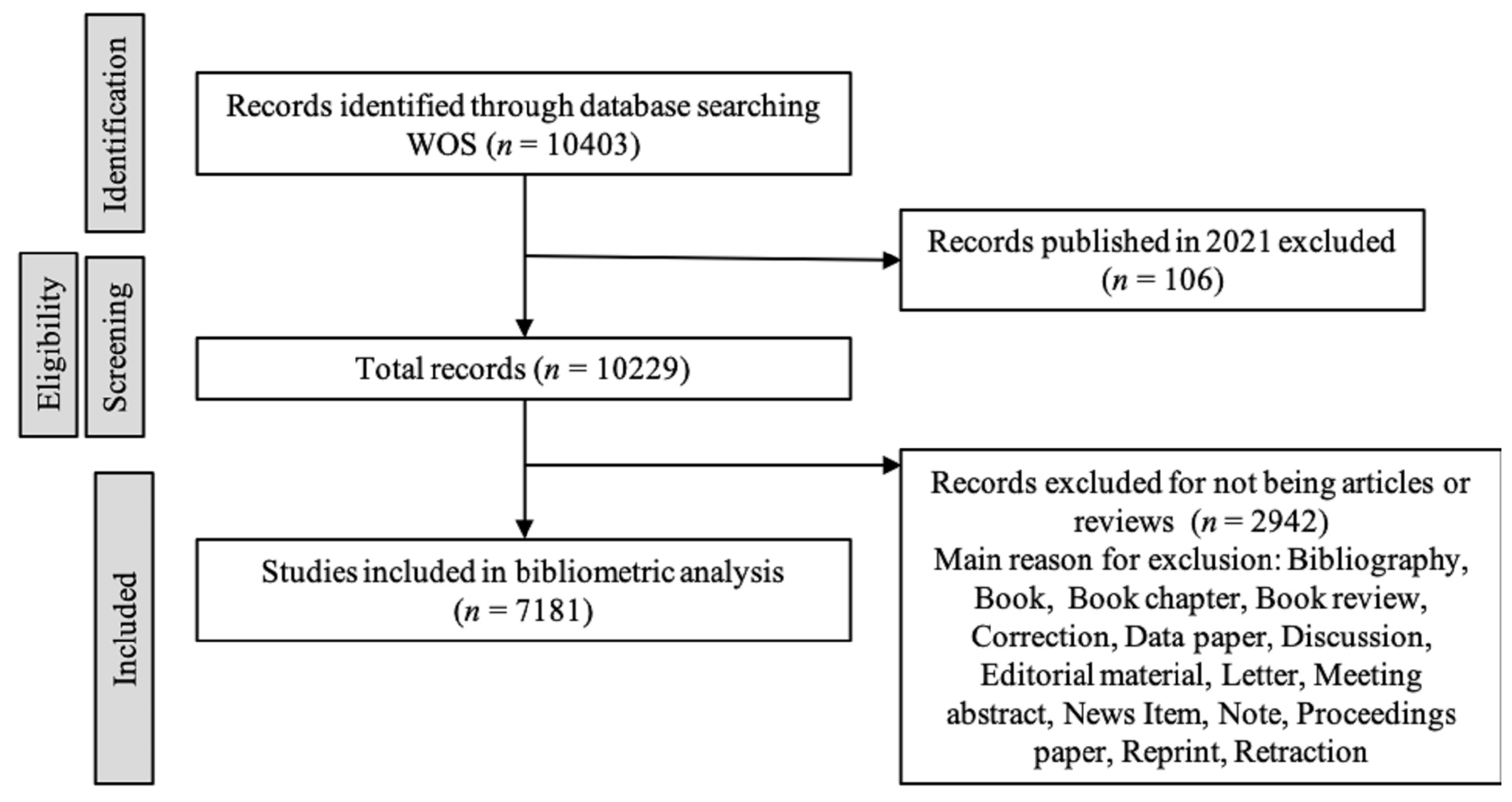

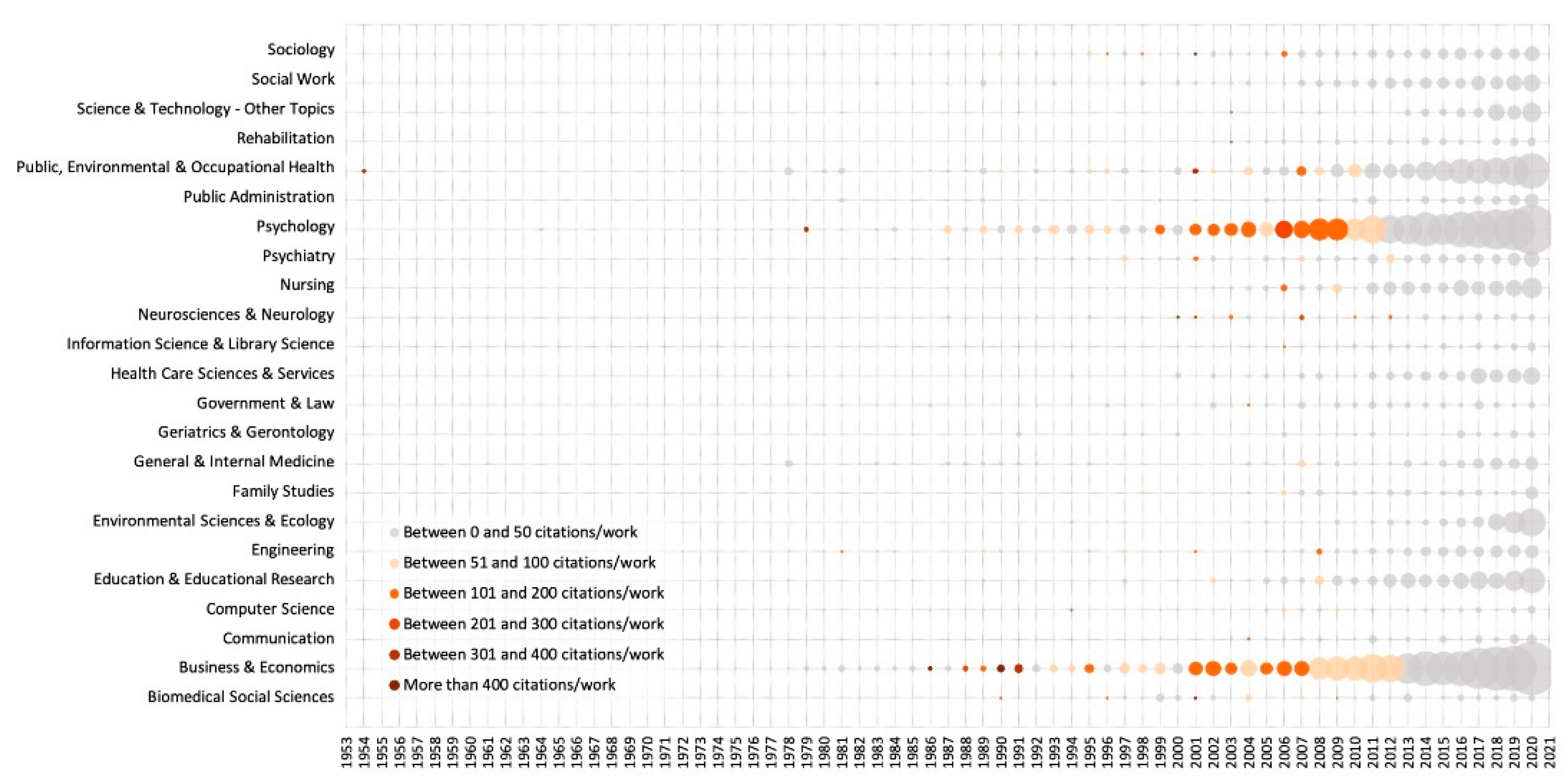
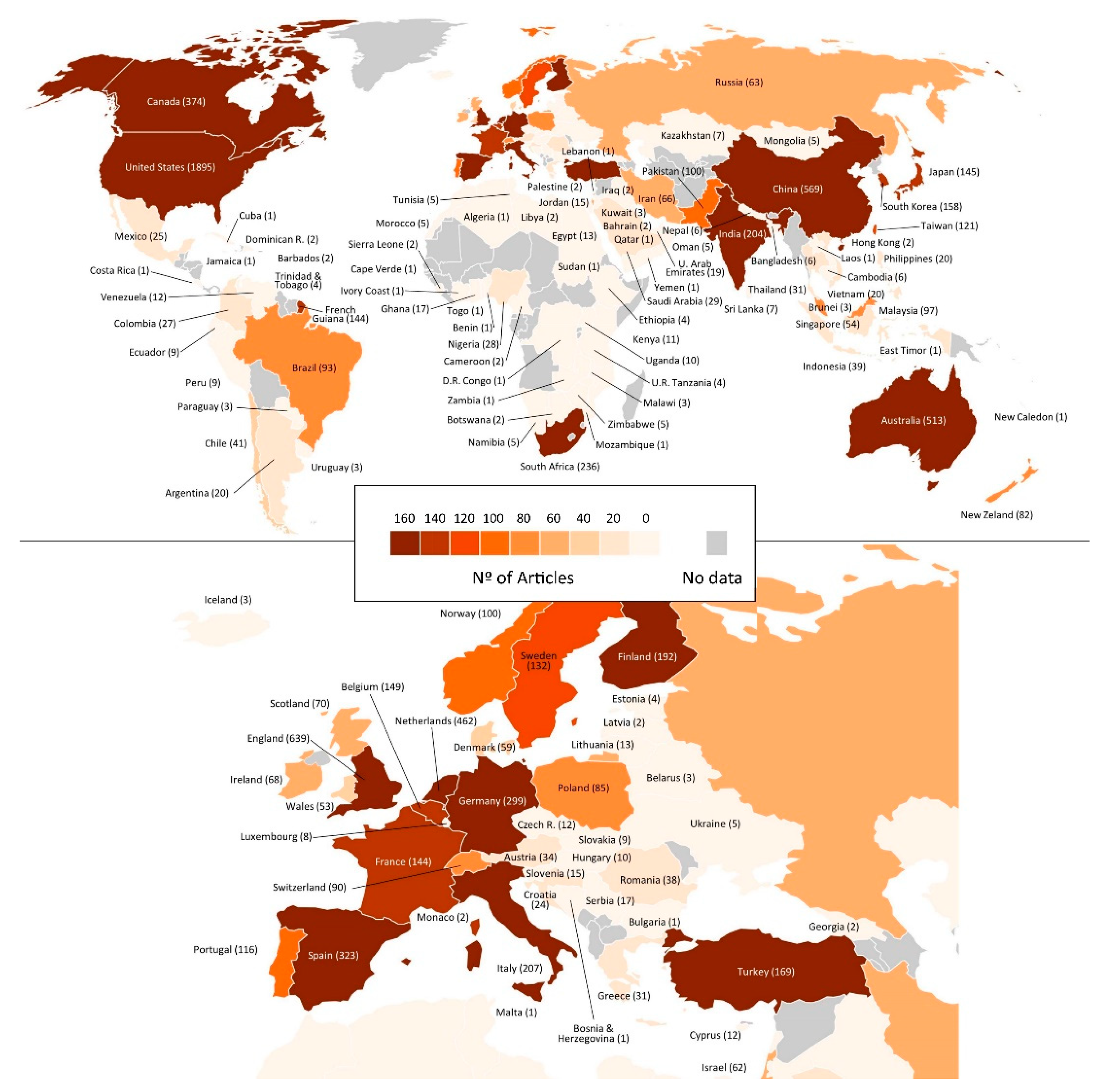
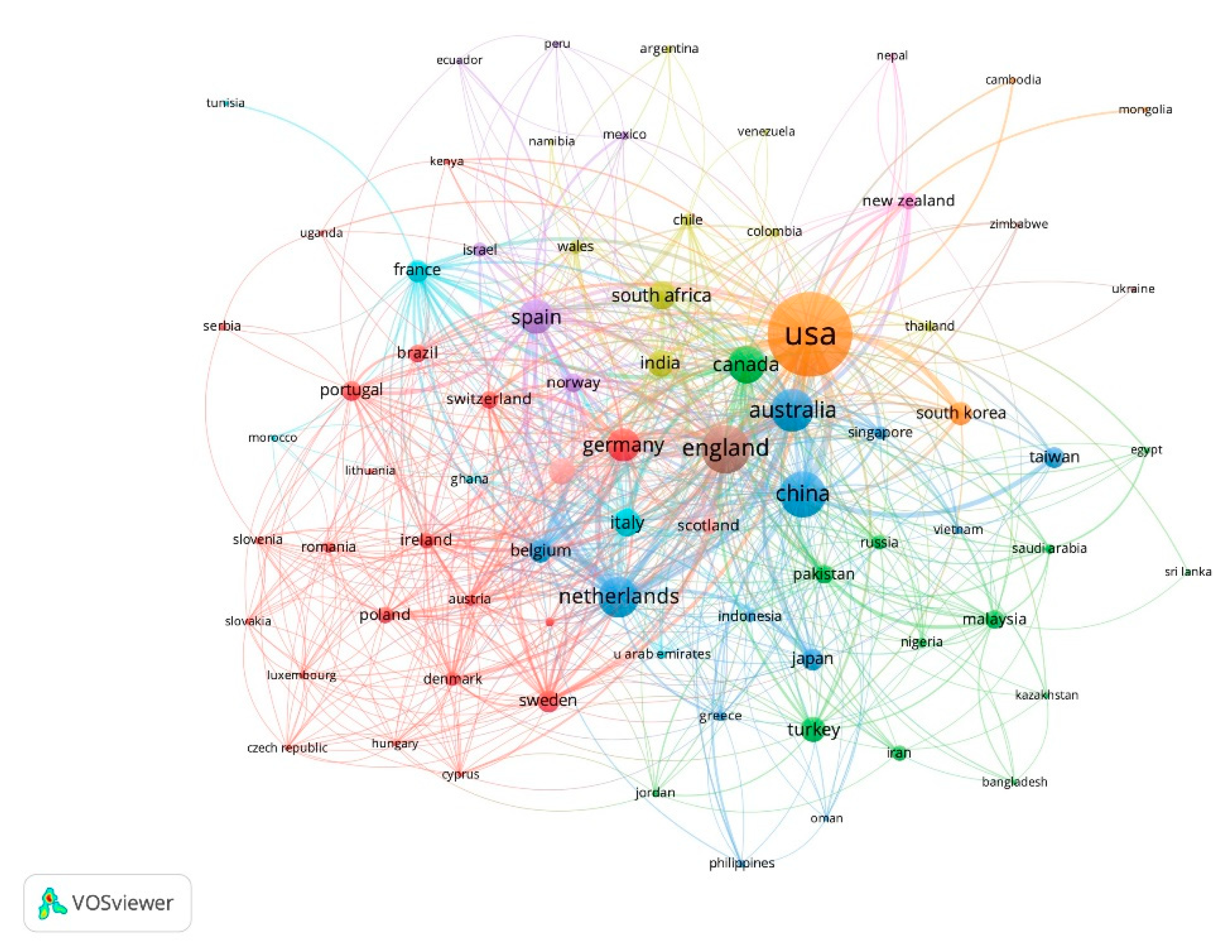

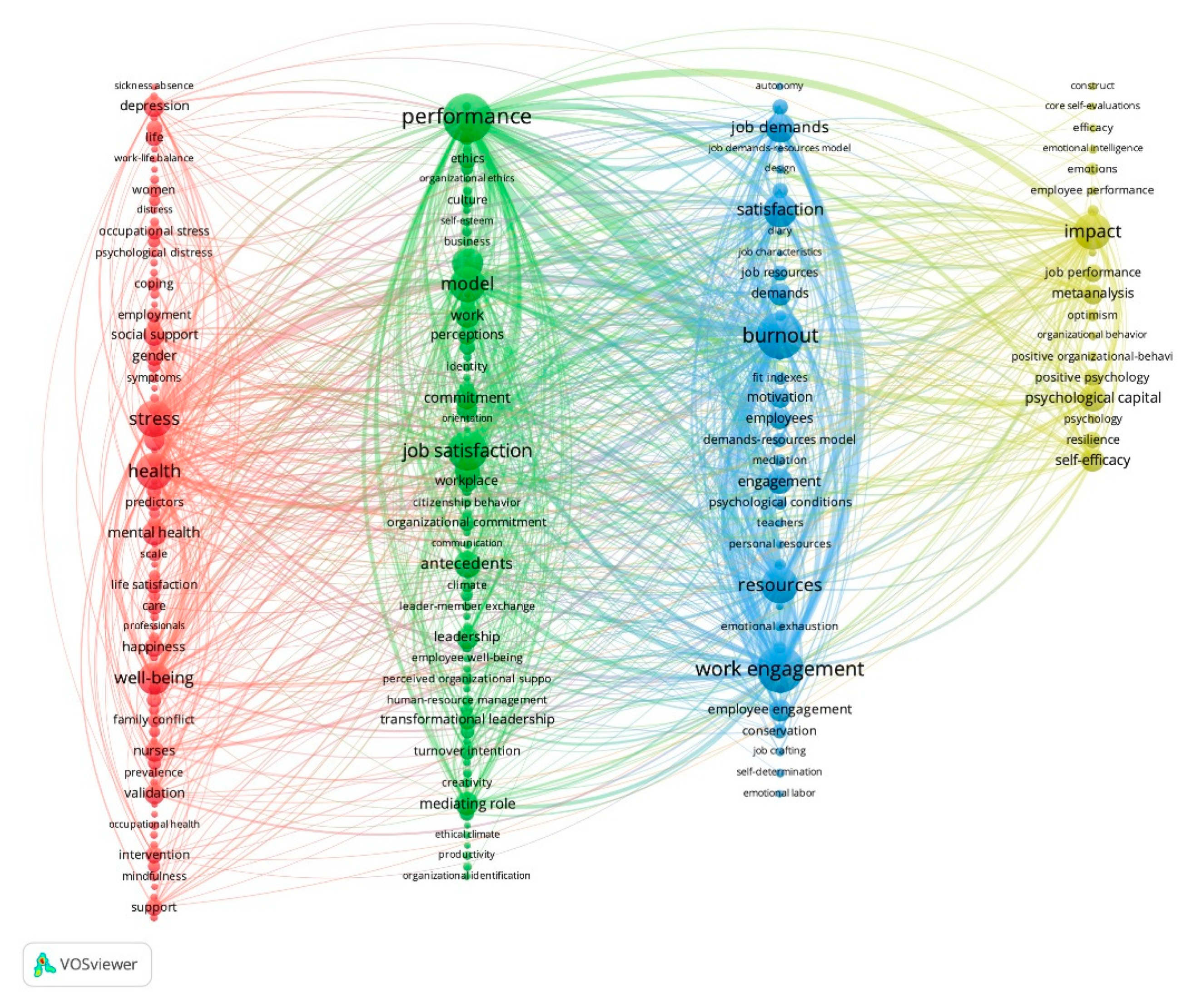
| Incubation | Initiation | Exponential Growth | |||||||
| Countries | 16 | 46 | 122 | ||||||
| Articles | 137 | 788 | 8044 | ||||||
| Citations | 6357 | 60,325 | 137,942 | ||||||
| Citations/work | 46.40 | 76.55 | 17.15 | ||||||
| Top 5 | Country | D 1 | Cites | Country | D 1 | Cites | Country | D 1 | Cites |
| United States | 78 | 5211 | United States | 341 | 26,464 | United States | 1476 | 32,022 | |
| Russia | 20 | 10 | United Kingdom | 69 | 3819 | China | 562 | 7940 | |
| United Kingdom | 8 | 249 | Canada | 58 | 3952 | United Kingdom | 562 | 9654 | |
| Canada | 7 | 173 | The Netherlands | 45 | 8516 | Australia | 490 | 9312 | |
| Japan | 7 | 39 | Germany | 31 | 2439 | The Netherlands | 416 | 19,095 |
| Journal | D 1 | Cites | C/W 2 | IF 3 | Q 4 | WoSCC Category 5 |
|---|---|---|---|---|---|---|
| Journal of Business Ethics | 263 | 10,950 | 41.63 | 4.141 | Q1 | BUSS, ETH |
| Frontiers in Psychology | 146 | 986 | 6.75 | 1.784 | Q2 | PSYC |
| Inter. J. of Environ. Research and Public Health | 108 | 509 | 4.71 | 2.341 | Q2 | ESandE, PEOH |
| J. of Vocational Behavior | 69 | 5355 | 77.61 | 3.396 | Q1 | PSYC |
| Work and Stress | 67 | 5055 | 75.45 | 3.390 | Q1 | PSYC |
| European J. of Work and Organizat. Psychol. | 64 | 2184 | 34.13 | 2.504 | Q1 | PSYC, BandE |
| Inter. J. of Human Resource Management | 61 | 2002 | 32.82 | 2.908 | Q2 | BandE |
| J. of Occupational Health Psychology | 59 | 3620 | 61.36 | 6.941 | Q1 | PSYC, PEOH |
| Sustainability | 58 | 223 | 3.84 | 1.711 | Q2 | SandTOT, ESandE |
| SA J. of Industrial Psychology 6 | 51 | 956 | 18.75 | - | - | PSYC |
| J. of Happiness Studies | 49 | 1036 | 21.14 | 2.179 | Q1 | PSYC, SCOT |
| J. of Occupational and Environmental Medicine | 46 | 659 | 14.33 | 1.436 | Q3 | PEOH |
| J. of Occupational and Organizational Psychol. | 46 | 3563 | 77.46 | 2.545 | Q2 | PSYC, BandE |
| Plos One | 45 | 661 | 14.69 | 2.650 | Q2 | SandTOT |
| Human Relations | 45 | 2381 | 52.91 | 3.320 | Q1 | BandE, SCOT |
| Social Indicators Research | 43 | 647 | 15.05 | 1.874 | Q2 | SCIN, SOC |
| J. of Organizational Behavior | 44 | 5002 | 113.68 | 4.832 | Q1 | BandE, PSYC |
| Personnel Review | 42 | 696 | 16.57 | 1.731 | Q2 | BandE, PSYC |
| Social Behavior and Personality | 39 | 326 | 8.36 | 0.575 | Q4 | PSYC |
| J. of Nursing Management | 37 | 817 | 22.08 | 1.773 | Q1 | BandE, NUR |
| First area of productivity | 2394 | 71,367 | 29.81 | |||
| Second area of productivity | 2611 | 26,053 | 9.98 | |||
| Third area of productivity | 782 | 11,962 | 5.50 |
| Year | Authors | Title | Journal | Citations |
|---|---|---|---|---|
| 1995 | Hosmer, L. T. | Trust—The connecting link between organizational theory and philosophical ethics [26] | Academy of Management Review | 914 |
| 1996 | Parasuraman, S., Purohit, Y. S., Godshalk, V. M., and Beutell, N. J. | Work and family variables, entrepreneurial career success, and psychological well-being [27] | Journal of Vocational Behavior | 385 |
| 1997 | Schaubroeck, J., and Merritt, D. E. | Divergent effects of job control on coping with work stressors: The key role of self-efficacy [28] | Academy of Management Journal | 218 |
| 1998 | De Jonge, J., and Schaufeli, W. B. | Job characteristics and employee well-being: a test of Warr’s Vitamin Model in health care workers using structural equation modelling [29] | Journal of Organizational Behavior | 154 |
| 1999 | Danna, K., and Griffin, R. W. | Health and well-being in the workplace: A review and synthesis of the literature [30] | Journal of Management | 580 |
| 2000 | Anshel, M. H. | A conceptual model and implications for coping with stressful events in police work [31] | Criminal Justice and Behavior | 209 |
| 2001 | Deci, E. L., Ryan, R. M., Gagne, M., Leone, D. R., Usunov, J., and Kornazheva, B. P. | Need satisfaction, motivation, and well-being in the work organizations of a former eastern bloc country: A cross-cultural study of self-determination [32] | Personality and Social Psychology Bulletin | 841 |
| 2002 | Luthans, F. | The need for and meaning of positive organizational behavior [7] | J. of Organizational Behavior | 994 |
| 2003 | Sonnentag, S. | Recovery, work engagement, and proactive behavior: A new look at the interface between nonwork and work [33] | Journal of Applied Psychology | 855 |
| 2004 | Baard, P. P., Deci, E. L., and Ryan, R. M. | Intrinsic need satisfaction: A motivational basis of performance and well-being in two work settings [34] | Journal of Applied Social Psychology | 821 |
| 2005 | Salanova, M., Agut, S., and Peiro, J. M. | Linking organizational resources and work engagement to employee performance and customer loyalty: The mediation of service climate [35] | Journal of Applied Psychology | 996 |
| 2006 | Schaufeli, W. B., Bakker, A. B., and Salanova, M. | The measurement of work engagement with a short questionnaire—A cross-national study [36] | Educational and Psychological Measurement | 2386 |
| 2007 | Luthans, F., Avolio, B. J., Avey, J. B., and Norman, S. M. | Positive psychological capital: Measurement and relationship with performance and satisfaction [37] | Personnel Psychology | 1220 |
| 2008 | Bakker, A. B., Schaufeli, W. B., Leiter, M. P., and Taris, T. W. | Work engagement: An emerging concept in occupational health psychology [38] | Work and Stress | 824 |
| 2009 | Schaufeli, W. B., Bakker, A. B., Van Rhenen, W. | How changes in job demands and resources predict burnout, work engagement, and sickness absenteeism [39] | Journal of Organizational Behavior | 817 |
| 2010 | Bakker, A. B., and Bal, P. M. | Weekly work engagement and performance: A study among starting teachers [40] | J. of Occupational and Organizational Psychology | 433 |
| 2011 | Christian, M. S., Garza, A. S., and Slaughter, J. E. | Work engagement: A quantitative review and test of its relations with task and contextual performance [41] | Personnel Psychology | 958 |
| 2012 | Bakker, A. B., Tims, M., and Derks, D. | Proactive personality and job performance: The role of job crafting and work engagement [42] | Human Relations | 331 |
| 2013 | Karatepe, O. M. | High-performance work practices and hotel employee performance: The mediation of work engagement [43] | International J. of Hospitality Management | 162 |
| 2014 | Abbas, M., Raja, U., Darr, W., and Bouckenooghe, D. | Combined effects of perceived politics and psychological capital on job satisfaction, turnover intentions, and performance [44] | Journal of Management | 181 |
| 2015 | Barnes, C. M., Lucianetti, L., Bhave, D. P., and Christian, M. S. | You wouldn’t like me when I’m sleepy: leaders’ sleep, daily abusive supervision, and work unit engagement [45] | Academy of Management Journal | 134 |
| 2016 | Baron, R. A., Franklin, R. J., and Hmieleski, K. M. | Why entrepreneurs often experience low, not high, levels of stress: The joint effects of selection and psychological capital [46] | Journal of Management | 129 |
| 2017 | Di Fabio, A. | Positive healthy organizations: Promoting well-being, meaningfulness, and sustainability in organizations [47] | Frontiers in Psychology | 111 |
| 2018 | Tawfik, D. S., Profit, J., Morgenthaler, T. I., Satele, D. V., Sinsky, C. A., Dyrbye, L. N., Tutty, M. A., West, C. P., and Shanafelt, T. D. | Physician burnout, well-being, and work unit safety grades in relationship to reported medical errors [48] | Mayo Clinic Proceedings | 114 |
| 2019 | Schaufeli, V. B., Shimazu, A., Hakanen, J., Salanova, M., and De Witte, H. | An ultra-short measure for work engagement the UWES-3 validation across five countries [49] | European Journal of Psychological Assessment | 68 |
| 2020 | Qing, M., Asif, M., Hussain, A., and Jameel, A. | Exploring the impact of ethical leadership on job satisfaction and organizational commitment in public sector organizations: The mediating role of psychological empowerment [50] | Review of Managerial Science | 24 |
Publisher’s Note: MDPI stays neutral with regard to jurisdictional claims in published maps and institutional affiliations. |
© 2021 by the authors. Licensee MDPI, Basel, Switzerland. This article is an open access article distributed under the terms and conditions of the Creative Commons Attribution (CC BY) license (https://creativecommons.org/licenses/by/4.0/).
Share and Cite
Martín-del-Río, B.; Neipp, M.-C.; García-Selva, A.; Solanes-Puchol, A. Positive Organizational Psychology: A Bibliometric Review and Science Mapping Analysis. Int. J. Environ. Res. Public Health 2021, 18, 5222. https://doi.org/10.3390/ijerph18105222
Martín-del-Río B, Neipp M-C, García-Selva A, Solanes-Puchol A. Positive Organizational Psychology: A Bibliometric Review and Science Mapping Analysis. International Journal of Environmental Research and Public Health. 2021; 18(10):5222. https://doi.org/10.3390/ijerph18105222
Chicago/Turabian StyleMartín-del-Río, Beatriz, Marie-Carmen Neipp, Adrián García-Selva, and Angel Solanes-Puchol. 2021. "Positive Organizational Psychology: A Bibliometric Review and Science Mapping Analysis" International Journal of Environmental Research and Public Health 18, no. 10: 5222. https://doi.org/10.3390/ijerph18105222
APA StyleMartín-del-Río, B., Neipp, M.-C., García-Selva, A., & Solanes-Puchol, A. (2021). Positive Organizational Psychology: A Bibliometric Review and Science Mapping Analysis. International Journal of Environmental Research and Public Health, 18(10), 5222. https://doi.org/10.3390/ijerph18105222






